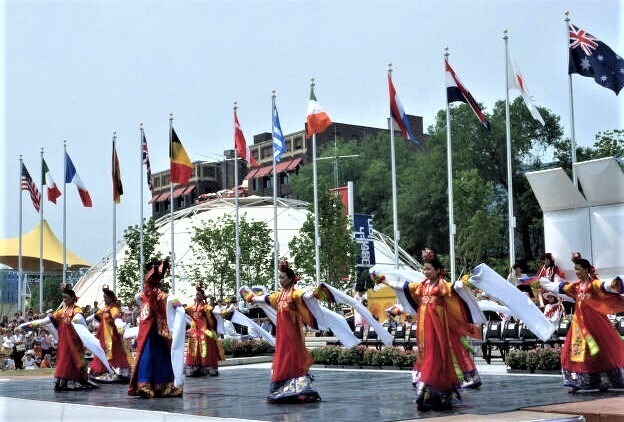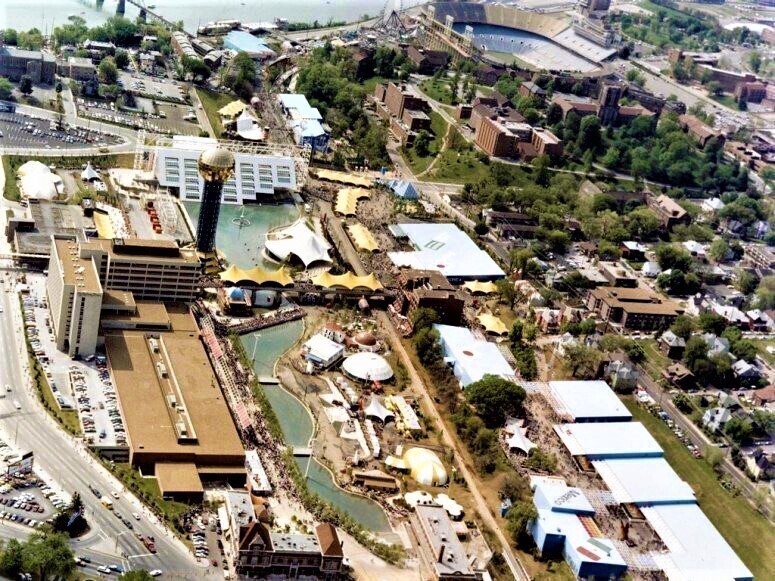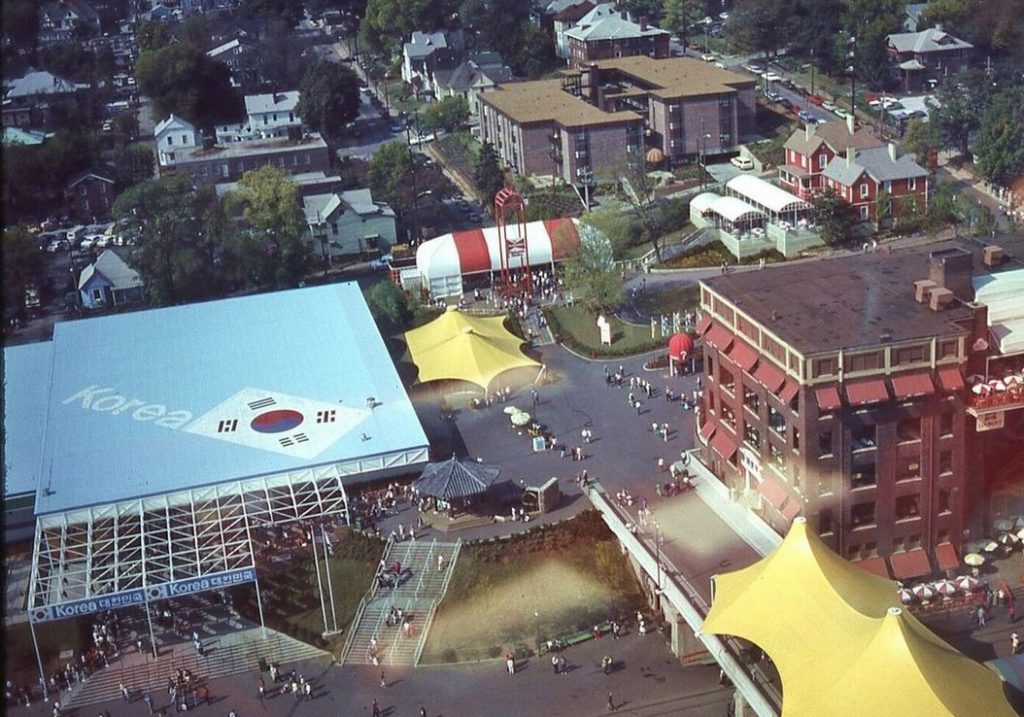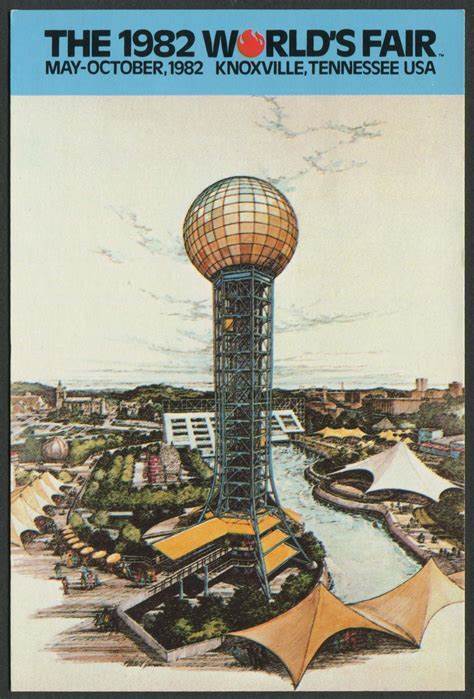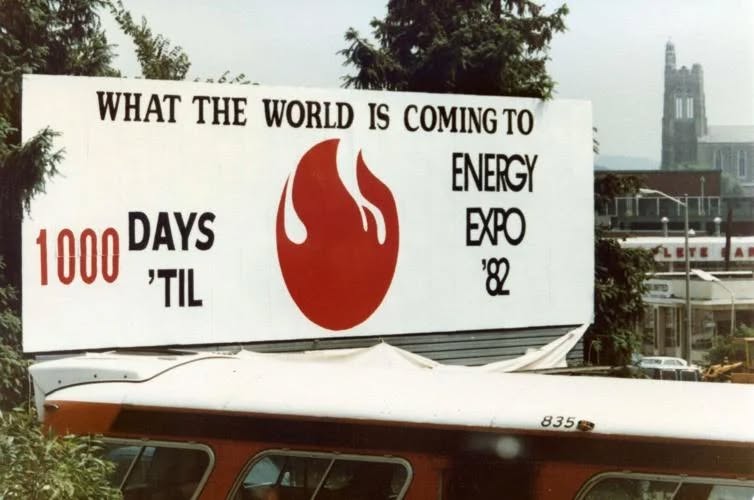In 1982, a World’s Fair was held in Knoxville Tennessee, my hometown. Dubbed the “Energy Exposition”, there was a full six months of activities and displays from the United States and over 25 countries, and over 11 million visitors over the Fair’s run. I was fortunate to be a part of the planning and execution of a major exhibit to include Ham Radio as part of the 1982 World’s Fair.
The following article was published in the February 1983 issue of 73 Magazine describing the ham radio exhibit and how it all came together.
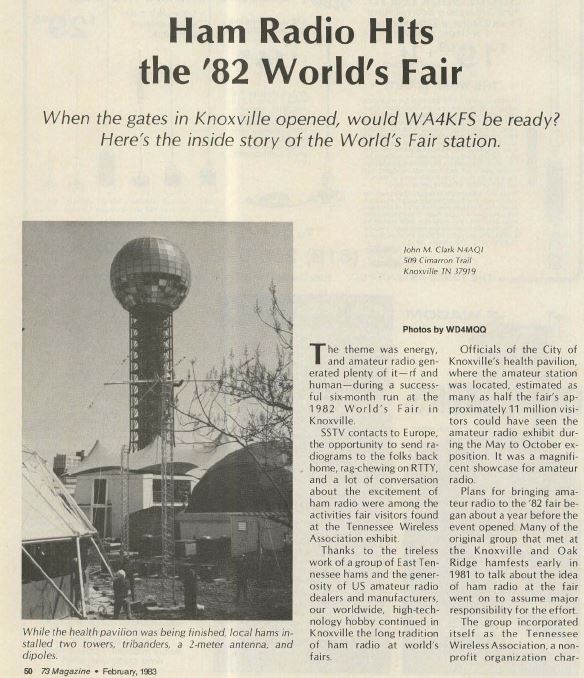
Ham Radio Hits the ’82 World’s Fair
When the gates in Knoxville opened, would WA4KFS be ready? Here ‘s the inside story of the World’s Fair station.
By John M Clark, N4AQI (photos by WD4MQQ)
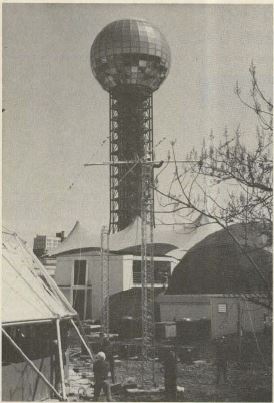
The theme was energy, and amateur radio generated plenty of it – rf and human -during a successful six-month run at the 1982 World ‘s Fair in Knoxville.
SSTV contacts to Europe, the opportunity to send radiograms to the folks back home, rag-chewing on RTTY, and a lot of conversation about the excitement of ham radio were among the activities fair visitors found at the Tennessee Wireless Association exhibit.
Thanks to the tireless work of a group of East Tennessee hams and the generosity of US amateur radio dealers and manufacturers, our worldwide, high -technology hobby continued in Knoxville the long tradition of ham radio at world’s fairs.
Officials of the City of Knoxville’s health pavilion, where the amateur station was located, estimated as many as half the fair’s approximately 11 million visitors could have seen the amateur radio exhibit during the May to October exposition. It was a magnificent showcase for amateur radio.
Plans for bringing amateur radio to the ’82 fair began about a year before the event opened. Many of the original group that met at the Knoxville and Oak Ridge hamfests early in 1981 to talk about the idea of ham radio at the fair went on to assume major responsibility for the effort.
The group incorporated itself as the Tennessee Wireless Association, a nonprofit organization chartered for the sole purpose of sponsoring an amateur radio exhibit at the fair. Under TWA president Ed Dunn W4NZW, the group’s first order of business was to approach fair officials about obtaining a site for the station. Virgil Davis KA4RPA, a TWA officer, talked with Knoxville mayor Randy Tyree and secured a location in the city’s health pavilion. Health care under emergency conditions was the theme of several exhibits in the pavilion, and the mayor and city officials felt the station would be appropriate there because of the emergency-communications aspect of the amateur service.
The site was superb. The health pavilion was a striking geodesic dome in the
center of the fair site, near the Sunsphere, the fair’s theme structure. An additional benefit was being located in a high-traffic area near the pavilion’s entrance.
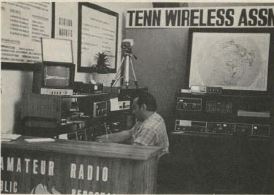
certificate and QSLs were available from the Tennessee Wireless Association.
With the exhibit space tied down, TWA officers turned their attention to lining up equipment which would demonstrate the diversity of amateur radio. Ten-Tec Inc., located in nearby Sevierville, was asked to supply HF rigs for three stations. The company agreed, and Tom Salvetti WD4FVU of Ten-Tec accepted the job as equipment coordinator for TWA.
Amateur dealers and manufacturers responded generously to Salvetti’s calls, and approximately $20,000 worth of state-of-the-art gear was loaned and soon on its way to Knoxville.
L. B. Cebik W4RNL, who has written a book on station design, was called on to produce a layout making the most efficient use possible of the 105-square-foot space. Three stations, two designated for general operating and one for specialized communications, were planned.
Although equipment needs were largely met by dealers and manufacturers, funds for installation and operation of the station were needed. Eleven area radio clubs and more than 60 individual amateurs responded, and Jerry Goodchild K4DZR, TWA secretary/treasurer, reported that approximately $2000 was donated to support the station.
Jerry also accepted, with the help of station trustee Chip Coker KD4C, the job of scheduling control operators for the station. About 40 hams each month worked shifts of three to eight hours as control operators. The station was staffed almost all of the 12 hours per day the six-month fair was open.
TWA directors talked about asking the FCC for a special call sign for the station, hoping that Knoxville’s hosting the first world ‘s fair in the South would persuade the commission to relax regulations on special calls. Deciding that prospect was dim, Chip KD4C offered the use of WA4KFS, for which he is trustee. Perfect – the phonetics would be “Knoxville Fair Station.”
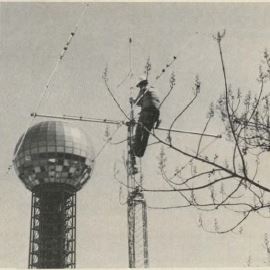
A year-long planning effort by TWA paid big dividends when the time came
to install the station. Construction at the fair site was on a tight schedule, with several buildings being ready only hours before the May 1st opening. While work continued on the health pavilion, TWA erected its two 50-foot towers and rotors from Hy-Gain/Telex and Texas Towers. Aboard were a Hy-Gain TH-3 and a V-2 for 2 meters and a KLM KT34A, Dipoles for 40 and 80 meters were cut , and feedlines from Times Wire and Cable Company were strung and ready to be hooked to the rigs. The three stations were built around Ten-Tec Omni C transceivers and Hercules solid-state linear amplifiers. Matching tuners, vfo’s, keys, and mikes were from Ten-Tec, with MFJ providing memory keyers and clocks. KDK Distributing of Nashville supplied KDK 2036 transceivers for 2 meters. All the gear was housed in stylish consoles from S-F Amateur Radio Services of California.
The latest RTTY equipment was sent to Knoxville by Hal Communications, and SSTV gear came from Robot Research. Both slowscan and Teletvpe attracted a lot of attention from non-hams who stopped by the exhibit.
RCA and Smith-Victor Sales supplied the SSTV camera, monitor, and tripod, and Overman International, which has a manufacturing plant in Knoxville,
provided chairs for the station, which was fully accessible to handicapped
operators.
A crowd of 82,000, including President and Mrs. Ronald Reagan, enjoyed opening day ceremonies on May 1st. Shortly after the official festivities, WA4KFS went on the air. Pileups were common, as hams around the world wanted an ’82 World’s Fair QSL card or a special certificate for working the station and 10 other Tennessee hams from May to October.
Amateurs coming to Knoxville were provided with World’s Fair information via ham radio. A 2-meter information station was built and placed on the air by Robin Rumbolt WA4TEM. By keying the station on simplex and giving their call, hams received information on parking, shuttle bus service, and lodging. Area repeaters were monitored by operators who could give directions and answer questions about East Tennessee and the fair.
Many amateurs heard of WA4KFS from the 2-meter information station, but a large number said they knew about the exhibit before coming to Knoxville, thanks to the work of publicity director Steve Kercel AA4AK. Some hams spotted the tri-banders and followed the coax into the pavilion. All visiting amateurs were asked to sign the guest log at the reception counter and were given the opportunity to operate the station.
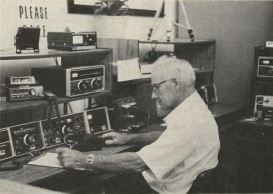
And operate they did – all modes, all bands. Some kept skeds they’d made in
advance, others checked into nets, some looked for DX. Many added considerable skill to the art of ragchewing.
Control operators answered thousands of questions from non-ham fair visitors and helped hundreds fill out radiograms, which were moved by Anita Teffeteller
NG4J, one of the nation’s top traffic handlers. Brochures about the station with tips on how to become a ham were given to those who stopped by for a chat.
Several control operators said they found conversations with fair visitors American as well as foreign interesting and educational. The foreigners came from Australia, South America, New Zealand, South Africa, Europe, and many other parts of the world.
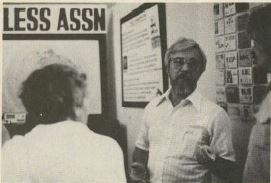
If you worked the World’s Fair station and want a QSL, send an SASE to Harvey Cross W4PKM. You can get the special certificate for working WA4KFS and 10 other Tennessee stations by sending $2 and log confirmation to Sarah Hickey N4EFA.
TWA, the 1982 World’s Fair, and the amateur community express their gratitude to the manufacturers and distributors who made the “Knoxville Fair Station” possible. Those firms were: Hal Communications, HyGain/Telex, KDK Distributing, KLM Electronics, MFJ, Overman International, RCA, Robot Research, S-F Amateur Radio Services, Smith-Victor Sales Corp ., Ten-Tec. Inc., Texas Towers, and Times Wire and Cable Co.
Thousands of people at the fair saw amateur radio at its finest, and East Tennessee hams who served as control operators and repeater monitors threw in a large dose of southern hospitality for good measure, look for some new hams on the airwaves because amateur radio went to the fair.
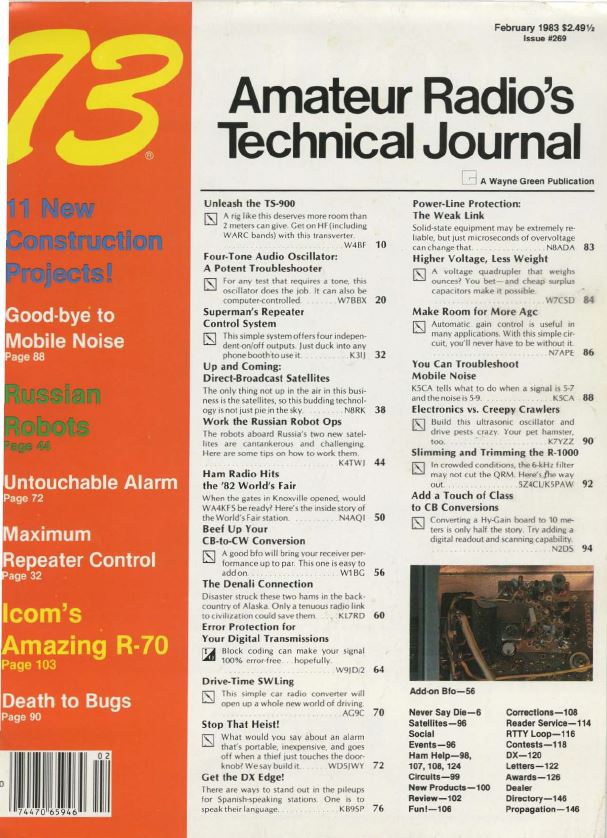
The Official QSL Card from the 1982 World’s Fair Amateur Radio Station
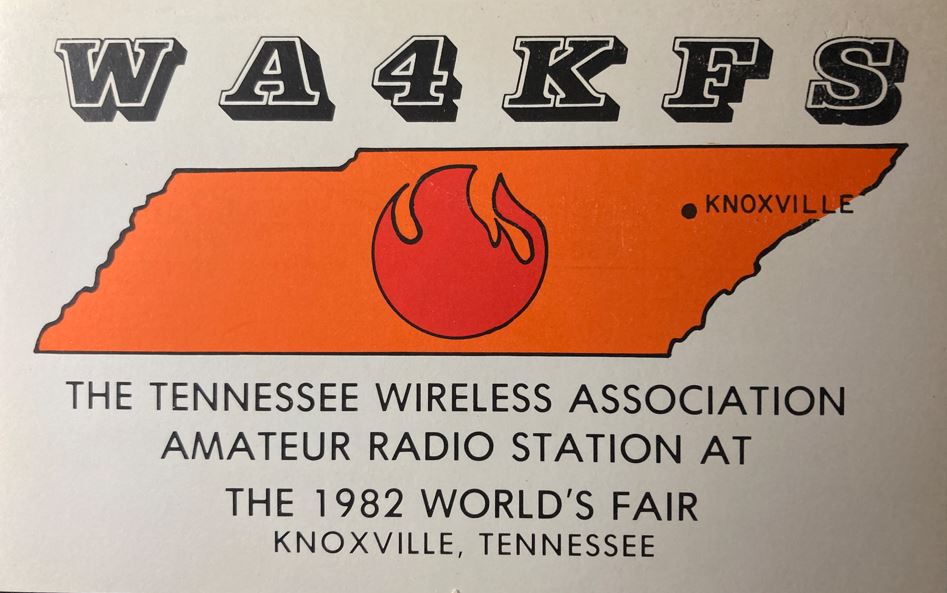
Here are a few pictures that show the 1982 World’s Fair site and the location of the WA4KFS 1982 World’s Fair “Knoxville Fair Station”
